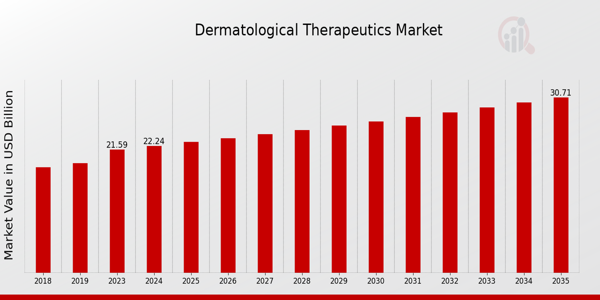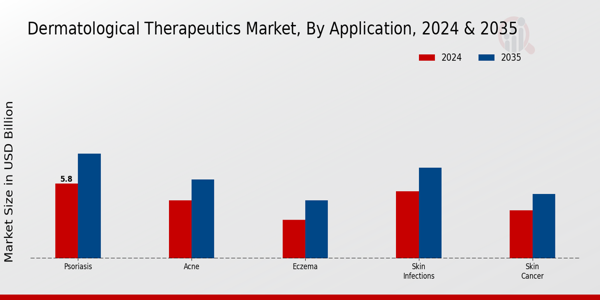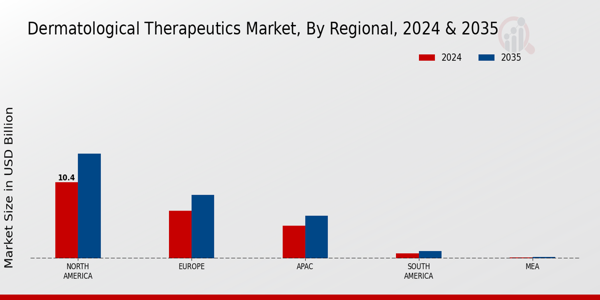Dermatological Therapeutics Market Overview
As per MRFR analysis, the Dermatological Therapeutics Market Size was estimated at 21.59 (USD Billion) in 2023. The Dermatological Therapeutics Market Industry is expected to grow from 22.24(USD Billion) in 2024 to 30.7 (USD Billion) by 2035. The Dermatological Therapeutics Market CAGR (growth rate) is expected to be around 2.98% during the forecast period (2025 - 2035).
Key Dermatological Therapeutics Market Trends Highlighted
The Global Dermatological Therapeutics Market continues to grow significantly owing to rising skin-related disorders and increased awareness of dermatological issues. The surge in skin disorders, including, but not limited to, acne, psoriasis, and eczema, is partly attributed to escalating levels of pollution, lifestyle changes, and increased UV exposure. This surge has heightened the need for effective solutions and increased the demand for treatment. Furthermore, innovation in technology and research has helped fuel innovation in drug development. Moreover, there is a growing focus on personalized medicine, which makes it possible for the new specialized treatment options to be tailored to the patient level.
There are considerable opportunities within the market, particularly in developing countries where access to healthcare is improving. As awareness of skin health rises, pharmaceutical companies can capitalize on this trend by offering products tailored to local preferences. The growth of e-commerce has further broadened access to dermatological products, allowing consumers to purchase treatments conveniently.
Collaborations between healthcare providers and pharmaceutical companies can also pave the way for new treatment modalities and improved patient outcomes as integrated care approaches gain traction. Recent trends include the rise of biological therapies and the use of advanced formulations that focus on efficacy and safety.
There is an increasing shift towards natural and organic ingredients as consumers seek safer and environmentally friendly options. Telemedicine has gained prominence, allowing patients to consult with dermatologists remotely, which expands access to care. This shift also reflects a growing demand for convenience in healthcare. As these trends continue to evolve, the dermatological therapeutics market is set to expand, creating a landscape rich in innovative solutions and improved patient care.

Source: Primary Research, Secondary Research, MRFR Database and Analyst Review
Dermatological Therapeutics Market Drivers
Rising Prevalence of Skin Disorders
The Global Dermatological Therapeutics Market Industry is primarily driven by the increasing prevalence of various skin diseases, including psoriasis, eczema, acne, and skin infections. These conditions have become more common due to various factors such as environmental pollution, changing lifestyles, and genetic predispositions. The growing awareness among the general population about the importance of skin health has led to a rising demand for dermatological treatments.
Medical advancements in diagnostic techniques and treatment options have also contributed to this trend, allowing for early detection and effective management of skin diseases. The increasing incidence of skin cancer, particularly melanoma, further escalates the demand for dermatological therapeutics. As the global population ages, the demand for effective and advanced dermatological products is expected to grow significantly, thus propelling the growth of the Global Dermatological Therapeutics Market Industry.
Moreover, the acceptance of dermatological products in preventive healthcare is creating opportunities for new therapies and treatments, thereby boosting market dynamics. The focus on research and development in the field of dermatology is also enhancing treatment efficacy and a tailored approach, which is crucial for meeting the diverse needs of patients across different regions and demographic groups. Consequently, the rising prevalence of skin disorders stands as a critical driver for market growth in the forthcoming years.
Advancements in Dermatological Treatments
The introduction of innovative therapies and advanced drug formulations is a significant driver in the Global Dermatological Therapeutics Market Industry. Research and development efforts have led to the emergence of biologics and targeted therapies that offer improved efficacy and safety profiles compared to traditional treatments. The innovations in drug delivery systems, including creams, ointments, and injectables, provide patients with more effective treatment options for various skin conditions.Furthermore, the integration of technology into dermatological therapies, such as teledermatology and AI-driven diagnostics, enhances diagnosis, treatment planning, and patient follow-ups, bolstering market growth.
Increased Healthcare Expenditure
The rise in global healthcare spending plays a pivotal role in driving the Global Dermatological Therapeutics Market Industry. As countries invest more in healthcare systems, there is an increased focus on innovative treatments and dermatological care. Higher expenditure allows for better access to advanced therapies, enhancing patient outcomes and satisfaction. Moreover, as the economic standard of living improves, individuals are more willing to invest in their health and skincare, which encourages the demand for dermatological products and services.
Dermatological Therapeutics Market Segment Insights
Dermatological Therapeutics Market Application Insights
The Global Dermatological Therapeutics Market, particularly within the context of Application, reflects a robust landscape characterized by diverse treatment options aimed at managing a variety of skin conditions. As of 2024, the revenue from the market stood at 22.24 USD Billion, demonstrating the critical demand for effective dermatological treatments. Within this expansive market, applications are primarily segmented into Psoriasis, Acne, Eczema, Skin Infections, and Skin Cancer, each contributing significantly to the overall market dynamics.
The market for Psoriasis is valued at 5.8 USD Billion in 2024, and it illustrates a significant share, highlighting its majority holding due to the increasing prevalence of the disease and the demand for innovative therapies to manage its chronic nature. Acne, another prominent segment, is projected to generate 4.5 USD Billion in revenue in the same year, making it an important area of focus owing to the high incidence rate among adolescents and young adults, which drives consistent market growth. Eczema follows closely with a valuation of 3.0 USD Billion, reflecting a notable market interest as more individuals seek solutions for managing the discomfort associated with this chronic condition.
Similarly, Skin Infections are valued at 5.2 USD Billion, showcasing their vital role in the overall market, largely due to a growing awareness of the implications of untreated dermatological infections and the rising incidence of skin-related pathologies influenced by environmental factors. The Skin Cancer segment, while smaller, reflects a significant urgency with a valuation of 3.74 USD Billion, driven by rising awareness about skin cancer prevention and treatment options among various demographics.
The targeted focus on these applications highlights key trends in the Global Dermatological Therapeutics Market industry as treatments evolve in response to demographic needs, technological advancements, and a shifting landscape toward personalized healthcare.
Overall, the Global Dermatological Therapeutics Market data signals a steady growth trajectory along these application lines, driven by a combination of increased awareness of skin health issues, rising pollution levels, and innovative therapeutic developments that cater to these specific ailments effectively. The continued progression in each application area symbolizes a growing market opportunity that stakeholders keenly pursue, reflecting the ongoing importance placed on dermatological health in contemporary healthcare.

Source: Primary Research, Secondary Research, MRFR Database and Analyst Review
Dermatological Therapeutics Market Route of Administration Insights
The Global Dermatological Therapeutics Market is experiencing steady growth, categorized notably by the Route of Administration. By 2024, the market achieved a valuation of approximately 22.24 billion USD, reflecting the growing demand for effective dermatological treatments. In this context, the route of administration plays a crucial role in delivering therapeutic agents, with various methods including topical, systemic, and injectable applications.
Topical administration is particularly significant as it allows for localized treatment, which often results in higher efficacy with fewer systemic side effects.Systemic administration is gaining traction due to its effectiveness in treating more severe dermatological conditions, while injectable methods offer rapid onset of action for patients requiring immediate relief. These different routes not only cater to diverse therapeutic needs but also enhance patient compliance and satisfaction.
The differentiation in Global Dermatological Therapeutics Market segmentation reveals opportunities for innovation and market expansion, driven primarily by advancements in formulation technologies and increasing awareness of skin health.However, challenges such as regulatory hurdles and the need for extensive clinical data continue to shape the industry's landscape. The market growth is further supported by the rising prevalence of skin disorders and a growing geriatric population, which require consistent dermatological care.
Dermatological Therapeutics Market Drug Class Insights
The Global Dermatological Therapeutics Market is poised for healthy growth, with a valuation of 22.24 billion USD in 2024. The Drug Class segment plays a critical role in this market, encompassing various essential treatments for skin conditions. Among these, corticosteroids are widely used for their anti-inflammatory properties, helping manage conditions such as eczema and psoriasis.
Antibiotics are significant in treating bacterial skin infections, while retinoids are essential for acne and other skin disorders, showcasing their importance in everyday dermatological care.Biologics have gained traction due to their targeted action in chronic skin diseases, providing effective relief where conventional therapies may fall short. Antifungals also dominate the market, which is crucial for addressing superficial and deeper fungal infections that can affect overall skin health.
The diversity in the Drug Class segment underlines the broader market trends, including increasing skin disease prevalence and growing consumer awareness, which continues to drive the Global Dermatological Therapeutics Market revenue. As market growth unfolds, the segmentation within the Drug Class will provide valuable insights into therapeutic approaches and product development.
Dermatological Therapeutics Market End User Insights
The Global Dermatological Therapeutics Market has demonstrated significant value, with an expected worth of 22.24 USD billion in 2024, showcasing its relevance in the healthcare landscape. This market is primarily segmented by End User, encompassing Hospitals, Dermatology Clinics, and Homecare, each playing a pivotal role in service delivery. Hospitals often handle severe dermatological conditions requiring advanced treatment options, making them an integral part of the overall market.
Dermatology Clinics offer specialized care, facilitating focused management of skin disorders, which contributes notably to market growth.Homecare segments cater to the growing need for convenience, allowing patients to manage treatments in familiar settings, thus holding substantial importance in enhancing patient compliance and comfort. Overall, the Global Dermatological Therapeutics Market revenue reflects a well-distributed demand across these end users, driven by an increasing prevalence of skin diseases and a rising awareness of skin health.
The Global Dermatological Therapeutics Market statistics suggest promising trends as the industry adapts to technological advancements and patient-centric approaches.This strategic segmentation allows for more tailored therapeutic solutions and positions the market for continued growth in the years to come.
Dermatological Therapeutics Market Regional Insights
The Global Dermatological Therapeutics Market revenue reflects a robust landscape segmented by region, with North America leading the charge, valued at 10.4 USD Billion in 2024 and expected to reach 14.29 USD Billion by 2035. This region dominates due to advanced healthcare infrastructure and a high prevalence of dermatological conditions. Europe follows, with a valuation of 6.5 USD Billion in 2024, showing significant growth prospects as awareness for skin-related treatments increases among the population.
The APAC region, valued at 4.5 USD Billion in 2024, is emerging as a critical contributor due to rising disposable incomes and increasing demand for innovative therapeutics.South America, although smaller with a valuation of 0.7 USD Billion in 2024, is witnessing increased market growth driven by healthcare improvements and expanding access to dermatological treatments. Meanwhile, the MEA segment holds a modest value of 0.14 USD Billion in 2024, yet remains significant as emerging economies focus on enhancing healthcare facilities. Overall, these insights from the Global Dermatological Therapeutics Market segmentation highlight the diverse opportunities presented in different regions, shaped by specific growth drivers and market dynamics.

Source: Primary Research, Secondary Research, MRFR Database and Analyst Review
Dermatological Therapeutics Market Key Players and Competitive Insights
The Global Dermatological Therapeutics Market is characterized by a diverse range of products aimed at treating various skin disorders, including psoriasis, eczema, and acne. This market has seen significant growth due to the increasing incidence of skin diseases, alongside a rising awareness of skin health among the global population. The competitive landscape is highlighted by numerous pharmaceutical companies striving to innovate and enhance their offerings in the realm of dermatological treatments. This area is heavily influenced by advancements in biotechnology, an increasing number of regulatory approvals for new therapies, and the rising popularity of biological medications.
With a keen interest in expanding product portfolios and addressing unmet medical needs, several players are positioning themselves strategically to gain market share in this lucrative segment.Amgen stands out in the Global Dermatological Therapeutics Market due to its robust pipeline and innovative product offerings. The company's strengths lie in its commitment to research and development, which has led to the introduction of several groundbreaking therapies tailored to treat complex dermatological conditions.
Amgen's scientific expertise allows it to leverage cutting-edge technologies, resulting in effective and long-lasting treatments that resonate well with healthcare professionals and patients alike. Additionally, its strong market presence is supported by strategic collaborations and partnerships, enhancing its ability to deliver targeted therapies. Amgen is also recognized for its patient-centric approach, focusing on improving quality of life through its dermatological products, thus making a significant impact on patient care in the dermatology field.Bristol-Myers Squibb has established a significant foothold in the Global Dermatological Therapeutics Market, primarily through its commitment to addressing serious chronic skin diseases.
The strength of Bristol-Myers Squibb lies in its extensive experience in biopharmaceuticals, leading to the development and commercialization of innovative therapies that effectively manage skin conditions such as psoriasis and atopic dermatitis. The company invests heavily in clinical trials and research initiatives, which enhance its product development capabilities and ensure that its offerings meet the evolving needs of patients. Furthermore, Bristol-Myers Squibb is known for its strategic partnerships and collaborations, enabling it to extend its reach within the dermatological space. Its focus on scientific rigor and fostering robust relationships within the healthcare community positions Bristol-Myers Squibb as a reputable leader in driving advancements in dermatological care.
Key Companies in the Dermatological Therapeutics Market Include
- Amgen
- Bristol-Myers Squibb
- Sanofi
- Pfizer
- Johnson and Johnson
- Eli Lilly
- Bayer
- Regeneron Pharmaceuticals
- Dermira
- AbbVie
- Merck and Co.
- GlaxoSmithKline
- L'Oreal
- AstraZeneca
- Novartis
Dermatological Therapeutics Market Industry Developments
Recent developments in the Global Dermatological Therapeutics Market have seen a notable increase in focus on innovative treatments and therapies for skin conditions. Companies like AbbVie and Eli Lilly are making strides with their respective initiatives targeting psoriasis and eczema, reflecting a surge in demand for effective dermatological solutions. Additionally, Amgen and Regeneron Pharmaceuticals are advancing their research in biologics, aimed at providing enhanced treatment options for chronic skin disorders. In terms of corporate dynamics, Merck & Co. has been active in acquiring technology and compounds that bolster their dermatological pipeline, while AstraZeneca is also exploring potential collaborations to expand its therapeutic offerings in this sector. The market is currently experiencing valuation growth as investors recognize the importance of dermatological health, with organizations such as Johnson & Johnson and GlaxoSmithKline scaling their efforts to meet the increasing
demand. Moreover, advancements in medical technology are driving innovation, spurring further investment from companies like Bristol-Myers Squibb and Bayer into dermatology-focused R&D initiatives, all contributing to a robust and evolving landscape in dermatological care.
Dermatological Therapeutics Market Segmentation Insights
Dermatological Therapeutics Market Application Outlook
- Psoriasis
- Acne
- Eczema
- Skin Infections
- Skin Cancer
Dermatological Therapeutics Market Route of Administration Outlook
- Topical
- Systemic
- Injectable
Dermatological Therapeutics Market Drug Class Outlook
- Corticosteroids
- Antibiotics
- Retinoids
- Biologics
- Antifungals
Dermatological Therapeutics Market End User Outlook
- Hospitals
- Dermatology Clinics
- Homecare
Dermatological Therapeutics Market Regional Outlook
- North America
- Europe
- South America
- Asia - Pacific
- Middle East and Africa
| Attribute/Metric Source: |
Details |
| MARKET SIZE 2023 |
21.59(USD Billion) |
| MARKET SIZE 2024 |
22.24(USD Billion) |
| MARKET SIZE 2035 |
30.7(USD Billion) |
| COMPOUND ANNUAL GROWTH RATE (CAGR) |
2.98% (2025 - 2035) |
| REPORT COVERAGE |
Revenue Forecast, Competitive Landscape, Growth Factors, and Trends |
| BASE YEAR |
2024 |
| MARKET FORECAST PERIOD |
2025 - 2035 |
| HISTORICAL DATA |
2019 - 2024 |
| MARKET FORECAST UNITS |
USD Billion |
| KEY COMPANIES PROFILED |
Amgen, BristolMyers Squibb, Sanofi, Pfizer, Johnson and Johnson, Eli Lilly, Bayer, Regeneron Pharmaceuticals, Dermira, AbbVie, Merck and Co., GlaxoSmithKline, L'Oreal, AstraZeneca, Novartis |
| SEGMENTS COVERED |
Application, Route of Administration, Drug Class, End User, Regional |
| KEY MARKET OPPORTUNITIES |
Telemedicine for dermatology services, Advancements in biologics and biosimilars, Increased awareness of skin conditions, Rising prevalence of dermatological disorders, Integration of artificial intelligence tools |
| KEY MARKET DYNAMICS |
Increasing skin disorders prevalence, Rising demand for personalized therapies, Advancements in dermatological research, Regulatory approval for new treatments, Growing awareness of skincare products |
| COUNTRIES COVERED |
North America, Europe, APAC, South America, MEA |
Frequently Asked Questions (FAQ) :
The Global Dermatological Therapeutics Market is expected to be valued at 22.24 USD Billion in 2024.
By 2035, the Global Dermatological Therapeutics Market is anticipated to reach a value of 30.7 USD Billion.
The expected CAGR for the Global Dermatological Therapeutics Market during the forecast period from 2025 to 2035 is 2.98%.
Psoriasis holds the largest market value in 2024, anticipated at 5.8 USD Billion.
The market value for Acne in the Global Dermatological Therapeutics Market is expected to reach 6.1 USD Billion by 2035.
North America is forecasted to have the highest market value in 2024, estimated at 10.4 USD Billion.
Europe's expected market value in the Global Dermatological Therapeutics Market by 2035 is estimated to be 8.65 USD Billion.
Key players in the Global Dermatological Therapeutics Market include Amgen, BristolMyers Squibb, Sanofi, Pfizer, and Johnson and Johnson.
The anticipated market size for Skin Cancer therapeutics in 2035 is projected to be 5.0 USD Billion.
The expected market value for Skin Infections in 2024 is estimated to be 5.2 USD Billion.

















